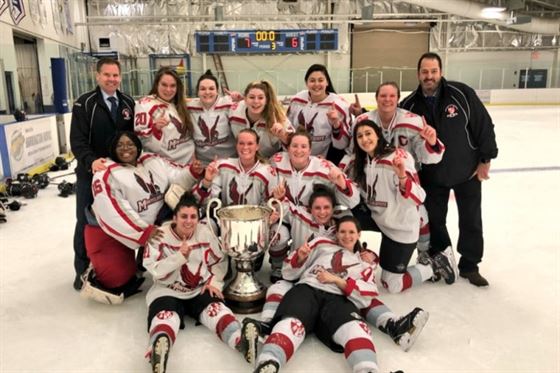Despite the wishes of many players, the Montclair State University women’s ice hockey team will not become a varsity sport anytime soon. Even though the program had a fantastic season with its first Delaware Valley Collegiate Hockey Conference (DVCHC) Championship win and an invitation to the Atlantic Hockey Conference Association (ACHA) National Tournament, many factors are taken into consideration when making a club sport into a varsity sport as explained by Holly P. Gera, director of intercollegiate athletics.
“There are many factors that go into starting an [National Collegiate Athletic Association (NCAA)] varsity sport,” Gera wrote in an email. “Just some of the things that have to be considered are: Title IX compliance, facilities, budget, personnel, support staff – including athletic training, sports information, advising and compliance, viability of the sport, conference sport sponsorship, etc.”
The four-year-old program, which was originally started by several students on a Facebook page, has grown massively. The team maintained an undefeated season, along with its other successes. Many of the players believed that this proved that the team should become a varsity sport.
“That was the goal when we started [the team] years ago,” said senior forward and English major Brittany Meneghin. “Especially with the success we have had this year, I think that there is no doubt that we should be a school team.”
Head coach Dave Solomon also said that he would like to see the team at an NCAA Division III level.
“That’s kind of our goal to grow the program as we get a more steady influx of players coming in,” Solomon said. “Yeah, we would love to see it get to that level of Division III.”
Even though becoming a varsity sport comes with more challenges such as stricter selection of players, many do not seem to mind it.
“We would have to become more of a team who attends practice more often,” wrote freshman defenseman Lexie Montez in an email. “The fact that it will become stricter in picking players is never a bad thing because it just means we become more competitive and hardworking. I have no problem with that.”
While there are many differences between a club sport and a varsity sport, the biggest is the cost. Club sports players pay a fee to play at the university. According to the women’s hockey team website, both new and returning players must pay $1,600 and $1,200 respectively. For some players this fee is a strain on them, especially as college students paying other bills.
“Club sports are pay-to-play sports,” said Kristin Iattarelli, senior co-captain and justice studies major. “So [at] the beginning of the year, we have an [admission] that we have to pay for the sport and that is kind of how it goes. Division III is what the rest of [Montclair State] competes in so they have everything paid for, but we have to work a little bit harder.”
Iattarelli mentioned that there are also options like scholarships and sponsors to help cover the cost of players’ fees in the club.
Nonetheless, after receiving the ACHA National Tournament invitation, the Red Hawks needed $15,000 to cover the cost of expenses for a competition in Columbus, Ohio in March. The team started its own GoFundMe page the day after they won the DVCHC Championship last Sunday night. The page already raised $2,145 of its official $5,500 goal by early March. Several other players have started to fundraise by selling chocolates and T-shirts.
While the team has made progress, some players found the process of fundraising frustrating.
“It is frustrating having to fundraise our money for nationals because despite all the work and effort we are putting in every game to win and make a name for Montclair State women’s hockey, we still have to dig out of our pockets to pay for this trip,” Montez wrote. “Rather [than] putting our attention into practicing for such a once-in-a-lifetime opportunity, we have to make sure we make enough money to even go to nationals.”
Even though varsity sports are mostly funded by the university, Gera mentioned that varsity sports fundraised too.
“While varsity sports are funded by the university, all our teams and student-athletes raise funds to support their programs and supplement their budgets,” Gera wrote. “This is mostly done to cover travel expenses, extra staffing and the cost of team gear. If a varsity team qualifies for an NCAA Championship, the NCAA reimburses a certain amount of the costs, but not necessarily all the costs.”
Along with the financial burden on players, the Red Hawks also dislike the university’s lack of acknowledgment for the team. Many believe that the university does not promote the team enough.
“If the promotion and hype [are] being given to one club sport, then I think that it should [be] given to all of them,” Iattarelli said.



